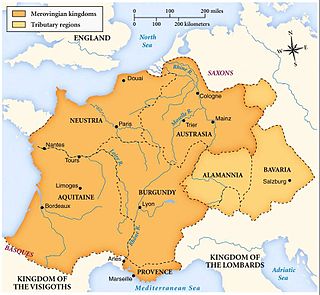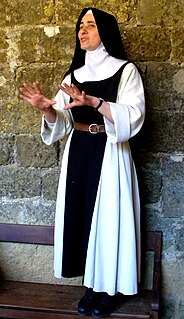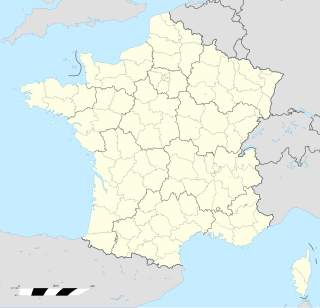Related Research Articles

In Catholicism, an abbess is the female superior of a community of nuns, which is often an abbey.

The Merovingian dynasty was the ruling family of the Franks from the middle of the 5th century until 751. They first appear as "Kings of the Franks" in the Roman army of northern Gaul. By 509 they had united all the Franks and northern Gaulish Romans under their rule. They conquered most of Gaul, defeating the Visigoths (507) and the Burgundians (534), and also extended their rule into Raetia (537). In Germania, the Alemanni, Bavarii and Saxons accepted their lordship. The Merovingian realm was the largest and most powerful of the states of western Europe following the breaking up of the empire of Theoderic the Great.

Osgyth was an English saint. She is primarily commemorated in the village of Saint Osyth, Essex, near Colchester. Alternative spellings of her name include Sythe, Othith and Ositha. Born of a noble family, she founded a priory near Chich which was later named after her.

Hilda of Whitby or Hild of Whitby is a Christian saint and the founding abbess of the monastery at Whitby, which was chosen as the venue for the Synod of Whitby. An important figure in the Christianisation of Anglo-Saxon England, she was abbess at several monasteries and recognised for the wisdom that drew kings to her for advice.

Kilcrea Friary is a ruined medieval abbey located near Ovens, County Cork, Ireland. Both the friary and Kilcrea Castle, which stands in ruin to the west, were built by Observant Franciscans in the mid 15th century under the patronage of Cormac Láidir MacCarthy, Lord of Muskerry, who was killed in battle in 1494 and is buried at the site.
Cyra may refer to:

January 4 - Eastern Orthodox liturgical calendar - January 6
Itta of Metz, O.S.B. was the wife of Pepin of Landen, Mayor of the Palace of the Kingdom of Austrasia. After his death, she founded the Abbey of Nivelles, where she became a Colombanian nun along with her daughter, Gertrude of Nivelles. Both are honored as saints by the Catholic Church.

Barking Abbey is a former royal monastery located in Barking, in the London Borough of Barking and Dagenham. It has been described as having been "one of the most important nunneries in the country".

Cistercian nuns are female members of the Cistercian Order, a religious order belonging to the Roman Catholic branch of the Catholic Church.

The United Dioceses of Meath and Kildare is a diocese in the Church of Ireland located in the Republic of Ireland. The diocese is in the ecclesiastical province of Dublin. Alone of English and Irish bishops who are not also archbishops, the Bishop of Meath and Kildare is styled "The Most Reverend".

The Bishop of Kildare was an episcopal title which took its name after the town of Kildare in County Kildare, Ireland. The title is no longer in use by any of the main Christian churches having been united with other bishoprics. In the Roman Catholic Church, the title has been merged with that of the bishopric of Leighlin and is currently held by the Bishop of Kildare and Leighlin. In the Church of Ireland, the title has been merged with that of the bishopric of Meath and is currently held by the Bishop of Meath and Kildare.

Saint-Saëns is a commune in the Seine-Maritime department in the Normandy region in northern France. A small town of farming and associated light industry situated by the banks of the river Varenne in the Pays de Bray, some 19 miles (31 km) southeast of Dieppe at the junction of the D929, D12, D99 and the D154 roads. Junction 11 of the A28 autoroute with the A29 autoroute is within the commune’s territory.

Saint Ælfflæd (654–714) was the daughter of King Oswiu of Northumbria and Eanflæd. She was abbess of Whitby Abbey, an abbey of nuns that were known for their skills in medicine, from the death of her kinswoman Hilda in 680, first jointly with her mother, then alone. Ælfflæd was particularly known for her skills in surgery and her personal attention to patients, as was Hilda, who was known for her personalized medical care.
Muskerry is a central region of County Cork, Ireland which incorporates the baronies of Muskerry West and Muskerry East. It is located along the valley of the River Lee and is bounded by the Boggeragh Mountains to the north and the Shehy Mountains to the south. The region is named after the Múscraige, who were an important Érainn people of Munster. It is also the name of an official Gaeltacht region in which Munster Irish is spoken. Gaeltacht villages include Béal Átha an Ghaorthaidh, Baile Bhuirne, Cúil Aodha and Cill na Martra. Major population centres include Ballincollig, Blarney and Macroom.
Saint Cera of Ireland was an abbess in the 7th century who died in 679. Her history is probably commingled with another Cera who lived in the 6th century. However, some authors maintain that monastic mistakes account for references to Cera in the 6th century or that a single Cera had an exceptionally long life span.

Domne Eafe, also Domneva, Domne Éue, Æbbe, Ebba, was, according to the Kentish royal legend, a granddaughter of King Eadbald of Kent and the foundress of the double monastery at Minster-in-Thanet during the reign of her cousin King Ecgberht of Kent. A 1000-year-old confusion with her sister Eormenburg means she is often now known by that name. Married to Merewalh of Mercia, she had at least four children. When her two brothers, Æthelred and Æthelberht, were murdered she obtained the land in Thanet to build an abbey, from a repentant King Ecgberht. Her three daughters all went on to become Abbesses and saints, the most famous of which, Mildrith, ended up with a shrine in St Augustine's Abbey, Canterbury.

Cwenburh of Wimborne was an 8th-century Anglo-Saxon saint, a sister of King Ine of Wessex and of Saint Cuthburh. Her sister Cuthburh was married to King Aldfrith of Northumbria and then became the first abbess of Wimborne monastery.
Mærwynn, also known as St. Merewenna or Merwinna, was a 10th-century saint and abbess of Romsey Abbey.
Cyra is a feminine given name and surname. People with the name include:
References
- Richard Challoner. Britannia Sancta: or, The Lives of the most Celebrated British, English, Scottish, and Irish Saints. Part II. London: Thomas Meighan, 1745.